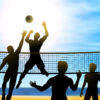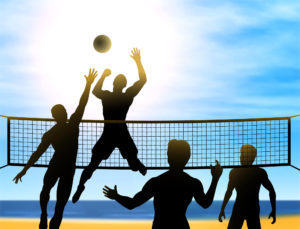
Better Vision, Better Volleyball
Good volleyball players must be athletic, and quick and be aware of the movement of not only the ball but the players around them. They play a fast-moving game and so must be hyperfocused when they are on the clock. Because of this, good vision is an integral part of being a good volleyball player.
Although good vision won’t make you jump higher, it can help you hit the ball in the correct location and it can help you work better as a teammate. Some of the vision skills that are most important in playing volleyball are eye tracking, depth perception, focus flexibility, peripheral awareness, dynamic visual acuity, and hand-eye coordination.
Eye Tracking
Eye tracking is the ability to follow a moving (and usually quick-moving) object with your eyes. This skill is important in volleyball because it helps the player determine where the ball is going in the field of play. This lets them figure out if they should be moving toward the ball or if they should be preparing for another player to touch the ball first.
One great exercise for a volleyball player to improve their eye tracking is to use a swinging tennis ball. Start this exercise by hanging a tennis ball from the ceiling by string so that is at eye level. On the ball write three different letters. Then swing the ball and call out the letter that is coming towards you as the ball travels around. This eye exercise helps your eyes follow the path of the ball and also makes them focus on the ball. You can start by just tracking the ball and adding letters as you get better at tracking.
Depth Perception
An athlete needs to see the world as clearly as possible to be successful in most sports, and this includes volleyball. Depth perception is key to clear vision on the court.
Depth perception is the ability to see the world in three dimensions. It helps people understand the size and movement of objects. It can let a player understand how quickly a ball is coming their way. In volleyball, this skill lets a player prepare to strike the ball in a way that keeps it in play, keeps the other team from scoring, and helps their team score.
One way you can improve depth perception is by performing the following exercise. Take a capped pen and stretch out your arms in front of you. Practice capping and uncapping the pen with your hands as far away from your eyes as possible. This will help strengthen the parts of your eye that control depth perception.
Focus Flexibility
Focus flexibility is the skill of being able to change the focus of your vision from a near object to a far object, or vice versa. In volleyball, this skill comes into play when watching the ball on the other end of the court, then needing to quickly change focus to setting up a response to a play at your end of the court.
Players can improve their focus flexibility with simple vision training. Try focusing on the computer screen in front of you, and then quickly shift your focus to a picture or an object across the room. Our 10-10-10 exercise will not only help you prevent digital eye strain, but it can also help you win your athletic endeavors! Repeatedly doing activities such as this over some time can help build up your focus flexibility.
Peripheral Awareness
Peripheral awareness is the ability of a player to see the action that is taking place on the side of their focus of vision. So if a volleyball player is facing the net, their teammates are in their peripheral area. When looking forward and watching the ball, peripheral awareness lets the player know if a teammate is moving toward them in an attempt to help save the ball or even to help set up a play. It helps keep players safe because it keeps players from colliding with each other when they are attempting to go after the ball at the same time.
Players can improve their peripheral awareness by trying the exercise two ball juggle. Using two balls, juggle them between your hands while keeping your eyes looking forward. The balls will pass in and out of your peripheral vision. Adding this to your training regimen should really help you out on the court.
Dynamic Visual Acuity
Dynamic visual acuity is the ability of the player to see clearly while moving or while watching the movement of play. For volleyball players, this means seeing the ball while moving into position to hit the ball. Sometimes this means the player must dive to save the ball from hitting the ground. Other times, it means setting the ball up into position for another player to spike the ball down on the opposing team’s side.
Dynamic visual acuity can be improved by jumping on a mini trampoline and reading eye charts at the same time. The player can have friends make new charts so he always has new charts to read off and memorization does not become a factor in the exercise.
Hand-Eye Coordination
 The ability of an athlete’s body to quickly react to the visual messages it is sending is called hand-eye coordination. For a volleyball player, this is often seen as a save. This is when the player dives for a ball that is about to hit the ground. The player keeps the ball in play and can keep the other team from scoring a point. Another example of hand-eye coordination in volleyball is when a player jumps in front of the net to block the ball when they see that the opposing team is about to spike.
The ability of an athlete’s body to quickly react to the visual messages it is sending is called hand-eye coordination. For a volleyball player, this is often seen as a save. This is when the player dives for a ball that is about to hit the ground. The player keeps the ball in play and can keep the other team from scoring a point. Another example of hand-eye coordination in volleyball is when a player jumps in front of the net to block the ball when they see that the opposing team is about to spike.
To improve hand-eye coordination, a player can try the eye exercise tennis racquet bounce. A player just needs a tennis ball and a tennis racquet. Hold the racquet face up, and bounce the ball off the face of the racquet into the air. To make it more difficult, bounce the ball high in the air, then spin it in a circle and try to bounce the ball off of the racquet again as it descends.
To improve your volleyball game, consider making your eyes as healthy as possible. This means keeping your body healthy, too. To improve your diet for better eyesight, try incorporating eye-strengthening vitamins, like Vitamins A, C, and E into your meals. Or, try some herbs for eyesight. The stronger your eyes are, the better your game will be!
Our Rebuild Your Vision Ocu-Plus Formula Contains All 17 Vitamins, Minerals, and Herbal Supplements to Improve Your Eye Health!




as a pickle ball player I find it difficult to follow the ball coming towards me. I am 82 and wonder if age is catching up to me. Glare in the gym, including the light reflecting off of the floor, is a big problem too. So, as I age do my eyes take a little longer to focus on a moving ball coming towards me? My depth perception may be good enough but the time it takes to adjust focus may be getting longer. I don’t seem to have this problem in tennis, at least not obviously. It would be great if someone would study this problem so seniors would at least have an excuse for missing the ball. I think if the balls were black or striped instead of solid white or yellow it might make it easier to see.